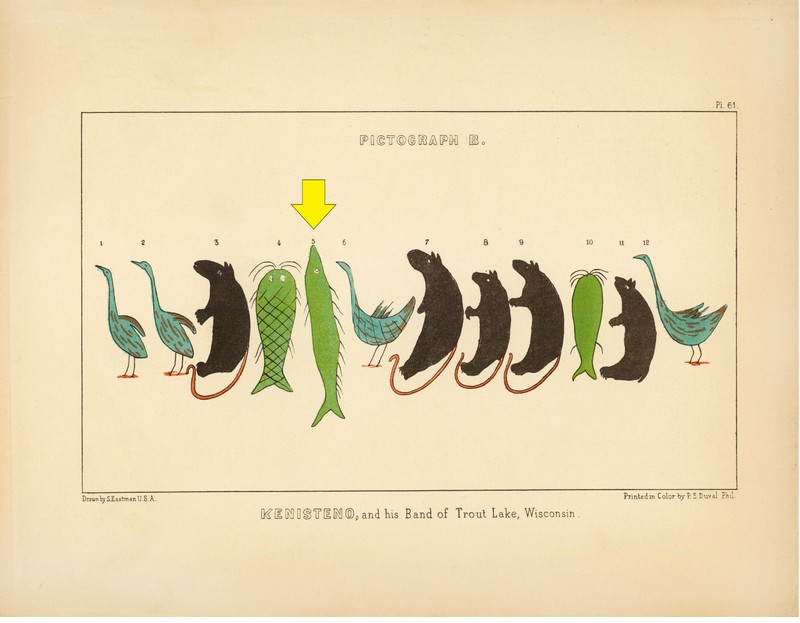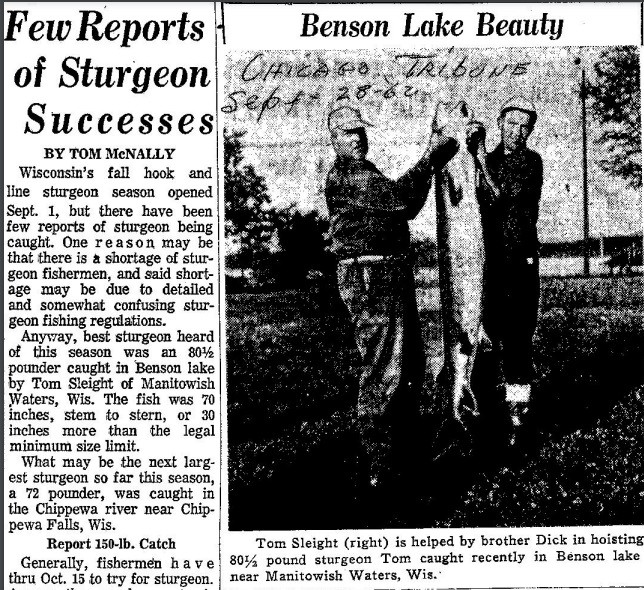Sturgeon Breeching on Benson Lake
Introduction
Text-to-speech Audio
One of the special Northwoods experiences few residents and visitors witness are sturgeon breeching out of the water. On Manitowish Waters Historical Society tours, breeching sturgeon is the most popular wildlife behavior guests witness. Trouble is, we have no certain method of determining where or when a sturgeon, which date back to prehistoric times, will fly out of the water and slam back on the surface.
The Manitowish River joins the Flambeau River to feed the Turtle Flambeau Flowage, which is a 13,000-acre body of water. The stretch from the Rest Lake Dam to the Turtle Flambeau Flowage Dam is good sturgeon viewing. Benson Lake is small and has a concentrated sturgeon population that provides the most "predictable" sturgeon breech viewing in our neck of the Northwoods.
The best way to access Benson Lake is by river. Whether launching upstream at Rest Lake Dam or on Highway 51, paddlers can easily access Benson Lake. Depending on water depth, there are some rapids on the river that make motorboat use between Highway 51 and Benson Lake impossible but fun for those in kayaks or canoes. For those who wish to access Benson Lake, use the Benson Lake boat landing on Benson Lake Road. This very rugged boat landing is also marked by the "Sturgeon Breeching on Benson Lake" pin on this Clio entry. Large motorboats will unlikely be able to launch at this landing. Moderate-sized boats will also struggle to launch and/or land their watercraft on this landing, which is best suited for kayak and canoe launching or small carry-in boats. Benson Lake boat landing is on public land and no fee is required.
Images
Breeching Sturgeon

Trout Lake band of the Ojibwe Totems, yellow arrow marks the Sturgeon Totem

1962 Benson Lake sturgeon caught By Richard Sleight Jr. and Tom Sleight

Backstory and Context
Text-to-speech Audio
For thousands of years, sturgeon played an important role for Indigenous communities. More than a super-food source, sturgeon was part of Ojibwe cultural identity, specifically cited in clans, totems and stories. Sturgeon was mostly harvested in the spring, during spawning season. Part of the processing of sturgeon included gathering fish oil, described as "the Indian's butter," which was prized and was a high-valued trade good. Sturgeon air bladders, called 'isinglass," were also traded like furs. Sturgeon weighed in excess of 200 pounds on the Manitowish River and delivered an enormous amount of oil-rich meat. A single sturgeon would provide the meat equivalent of several deer once dressed out.
The Ojibwe name for sturgeon is "Nahmay." Traditional stories celebrated sturgeon being so thick during the spring run that rivers looked purple. Other stories suggest the bravest Ojibwe would jump on spring ice flows, because the Nahmay would bump and push the ice. Ojibwe adventures sought the thrill of riding the ice on the back of a big Nahmay. Culturally, the Ojibwe made sturgeon or Nahmay a unique totem that identified family groups and clans. In 1848, the Trout Lake Band of Ojibwe, just upstream from Benson Lake, sent a petition endorsement to the U. S. government to secure regional reservations. In the 1851 lithograph by U. S. Army artist Seth Eastman, the Trout Lake Band's petition endorsement included, "Number 5, Ok-wa-gon, or the neck, a warrior of the Sturgeon totem," illustrating how important this prehistoric fish was to the Ojibwe culture and identity. This lithograph is included in the images below, and a link to a AccessGenealogy website explains all the clans and totems. See this entry's sources and links.
Les Jacobson lived on the west side of Benson Lake and was a determined advocate for sturgeon preservation. He worked with the DNR and other groups to preserve the sturgeon fishery on the Manitowish River. During the early spring sturgeon migration to the rapids just above Benson Lake, Les would be on his pier counting and sometimes naming the sturgeon. He would remark to passing spring canoers, "seen 5 this morning, the big one with a white spot above its eye was paired with a smaller surgeon." Les helped the DNR net sturgeon to strip eggs and gather milt for the Wild Rose Fish Hatchery. In the 1990s, Manitowish River fingerlings were released into the Turtle Flambeau Flowage, and those efforts proved fruitful as we see small sturgeon breeching from reintroduction efforts today.
Benson Lake residents Greg Holt and Justin Schultz have shared some helpful insights regarding sturgeon breeching and Benson Lake natural history:
- Sturgeon breech mostly from spring (June) through the early autumn (September, maybe early October), but the months that seem to have the most breeches are July and August.
- The time of day that sturgeon breech is a little tougher to determine, but you can check all day and even into the night. While out at night in a canoe watching for comets or star gazing, sturgeon have been heard breaching.
- Sturgeon breech sightings during a day range from zero to maybe two dozen or more during daylight hours. Greg and Justin report hearing/seeing several in a one-hour period many times, sometimes two or three within a couple of minutes.
- The lake is small enough and the fish are big enough, that if a person is out there and it's quiet, it is impossible to not notice the breeching.
- Just as the river enters Benson Lake from the upstream direction, there is an eagle nest on the right, high up in a pine that is very easy to spot. The nest has been there since at least 1994. The nest is somewhat smaller than it has been in the past, but up to six eagles have been spotted on that tree--either on or near the nest or in some of the lower branches, but seeing one or two is much more the norm.
- Also, a great place to see spawning action in the spring is roughly from the Highway 51 bridge through both sets of rapids leading into Benson Lake. The redhorse spawning is in the hundreds, with a single fish or groups of 20 or more swimming together in place against the current. And when they are spawning, the eagles are present and feeding. This should be where the sturgeon should be spawning as well, but the conditions have to be ideal. With the refilling of the chain, if the water temperature is right, the volume and speed of the water often is not. There is a "Sturgeon Watch" initiative by the Mercer DNR that was started before Covid, has not resumed yet, and may resume in the future.
Sources
AccessGenealogy. Algonquian Pictography, AccessGenealogy. January 1st, 2022. Accessed December 13th, 2022. https://accessgenealogy.com/michigan/algonquian-pictography.htm#identifier_1_304401.
Benton-Banai, Eddie. Nahmay (sturgeon) The King of Fish, MAZINAʹIGAN. October 1st, 2013. Accessed December 13th, 2022. http://data.glifwc.org/download/archive.maz/fall2013.pdf.
Eastman, Seth . Kenisteno, and his Band of Trout Lake, Wisconsin, Wisconsin Historical Society . January 1st, 1851. Accessed December 13th, 2022. https://www.wisconsinhistory.org/Records/Image/IM123351.
Holtzkamm, Tim E. Sturgeon Utilization by the Rainy River Ojibwa Bands , Carleton University. January 1st, 1987. Accessed December 13th, 2022. https://ojs.library.carleton.ca/index.php/ALGQP/article/download/946/830/0.
West, Don. Atlantic Sturgeon Reproducing In The James River, Virginia, Costal Angler Magazine The Angler . October 15th, 2019. Accessed December 11th, 2022. https://coastalanglermag.com/atlantic-sturgeon-virginia/.
West, Don. Atlantic Sturgeon Reproducing In The James River, Virginia, Costal Angler Magazine The Angler . October 15th, 2019. Accessed December 11th, 2022. https://coastalanglermag.com/atlantic-sturgeon-virginia/.
Eastman, Seth . Kenisteno, and his Band of Trout Lake, Wisconsin, Wisconsin Historical Society . January 1st, 1851. Accessed December 13th, 2022. https://www.wisconsinhistory.org/Records/Image/IM123351.
Manitowish Waters Historical Society
